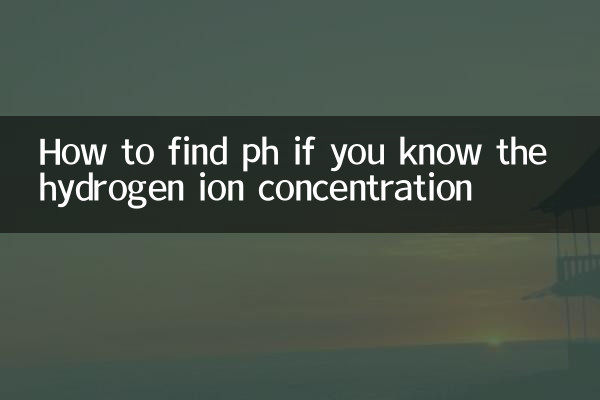How to find pH if you know the hydrogen ion concentration
In chemistry and biology, pH is an important indicator of the acidity or alkalinity of a solution. Understanding how to calculate pH from hydrogen ion concentration is important for both scientific research and practical applications. This article will introduce in detail the relationship between hydrogen ion concentration and pH value, and provide specific calculation methods.
1. Definition of pH value

The pH value is the negative logarithm of the hydrogen ion (H⁺) concentration in the solution, and its mathematical expression is:
pH = -log[H⁺]
Among them, [H⁺] represents the molar concentration of hydrogen ions (unit: mol/L). The range of pH value is usually between 0 and 14, pH=7 is neutral, pH<7为酸性,pH>7 is alkaline.
2. Conversion of hydrogen ion concentration and pH value
The following is the corresponding relationship between hydrogen ion concentration and pH value:
| Hydrogen ion concentration [H⁺] (mol/L) | pH value | Acidity and alkalinity |
|---|---|---|
| 1.0 × 10⁻¹ | 1 | Strongly acidic |
| 1.0 × 10⁻³ | 3 | Acidic |
| 1.0 × 10⁻⁷ | 7 | Neutral |
| 1.0 × 10⁻⁹ | 9 | alkaline |
| 1.0 × 10⁻¹⁴ | 14 | Strongly alkaline |
3. Steps to Calculate pH Value
1.Determine the hydrogen ion concentration: Obtain the molar concentration of hydrogen ions ([H⁺]) in the solution through experiments or known conditions.
2.Take the logarithm: Calculate the logarithm of hydrogen ion concentration (log[H⁺]).
3.Take negative value: Take the negative value to get the pH value.
Example: If [H⁺] = 2.5 × 10⁻⁵ mol/L in a certain solution, then:
pH = -log(2.5 × 10⁻⁵) ≈ -(-4.60) = 4.60
4. Practical Application of pH Value
pH value is widely used in daily life and industrial production, such as:
-drinking water: The ideal pH range is 6.5-8.5, ensuring safe drinking.
-Agriculture: Soil pH affects crop growth, and different crops have different requirements for pH value.
-Medicine: Human blood pH is maintained at 7.35-7.45. Deviation from this range may cause disease.
5. Things to note
1. The unit of hydrogen ion concentration must be mol/L, otherwise unit conversion needs to be performed first.
2. For extremely dilute or concentrated solutions, the pH value may exceed the range of 0-14.
3. In actual measurement, temperature will affect the pH value and needs to be calibrated under standard conditions.
Summary
Calculating pH from hydrogen ion concentration is a basic operation in chemistry, and mastering this method can help you better understand the acidity and alkalinity of a solution. This article provides detailed steps and examples, hoping to help you with your learning and research.

check the details

check the details